Chemical waste is defined as waste material of any solid, liquid, or gas material that requires proper management and disposal to prevent harm to the environment and human health. The NIH has procedures to identify, hazardous determination, and safely transfer chemical waste from the accumulation location to process for shipment. The Chemical Waste Management Procedures fall under federal regulations such as the Clean Water Act, Resource Conservation and Recovery Act, and local regulators such as Washington Suburban Sanitary Commission WSSC.
What qualifies as a chemical waste?
Oil, all types
| Batteries, all types | Gas cylinders and lecture bottles | Chemically contaminated dry waste
| Chemical reagents, all types |
| Fluoresecent light tubes | Sodium vapor and HID lamps | Pharmaceuticals, all types | Mercury-containing items | Non-radioactive lead shielding and lead scrap |
| Gels, agarose and pre-cast | Cytotoxic or cytostatic agents | X-ray film and photographic solutions | Empty bottles, RCRA empty or with residue | |
When does a product become waste?
- When a product becomes unwanted, abandoned, or deserted by the waste accumulator
- When a product has expired or is unidentifiable
- When a product is spent or is a completed product
- When a product has become unusable, broken, or impractical
Chemical Segregation
Many chemicals in your lab may react adversely when combined for disposal. It’s recommended that incompatible chemicals are stored in separate areas of your lab when feasible. Refer to Material Safety Data Sheets (MSDS) for specific incompatibilities. Here are general suggestions on what to separate from acids, oxidizers, and water-reactive chemicals:
Hazard Class and Their Common Laboratory Chemicals
Identify and Collect All Chemical Waste

| Use the Chemical Waste Tag provided by the Waste Contractor or available at the NIH Self-Service Store or in the NIH Stock Supply Catalog.
|

| Complete the fields on the front of the waste tag immediately after the first drop of waste or product is collected.
|

| Identify all major constituents and hazardous components by chemical name.
|

| Use NIH approved containers, funnels, and secondary containment to collect chemical waste.
|
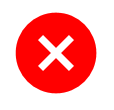
| Do not use an acronym or brand name to identify any chemical waste.
|

| Do not mix incompatible material (see Additional Information on Chemical Segregation).
|

| Do not place or transport waste containers beyond the accumulation location.
|

| Do not discard chemical waste to the sanitary sewer without authorization through the NIH Drain Discharge Guide.
|
How is Chemical Waste Collected?
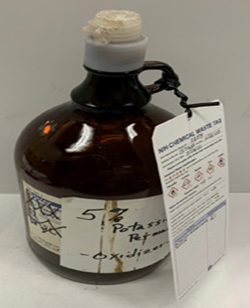
| Empty Chemical Bottles
- Any intact bottle with a cap is acceptable
- Used to collect small quantities of chemical waste
- Remove or alter original labeling to indicate waste
- The NIH Chemical Waste Tag is required for each bottle
|
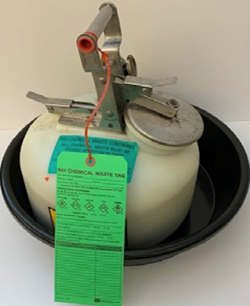
|
3-gallon Solvent Safety Can
- Flammable waste only, flammable solvents from processes like DNA synthesis or HPLC
- HPLC users can request containers with special fittings
- No nonflammable waste or mixtures with high water content in this container
- Use only the safety cans provided by Chemical Waste Services
|
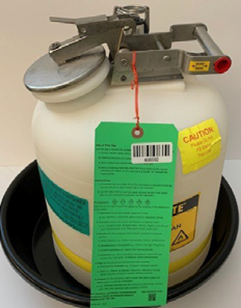
| 5-gallon Solvent Safety Can
- Flammable waste only, flammable solvents from processes like DNA synthesis or HPLC
- HPLC users can request containers with special fittings
- No nonflammable waste or mixtures with high water content in this container
- Use only the safety cans provided by Chemical Waste Services
|
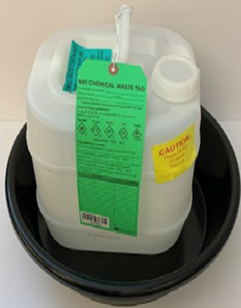
| 3-gallon Carboy (Blue or Clear)
- Aqueous wastes containing a range of chemicals
- When adding different chemical wastes, be careful not to create incompatible mixtures
- Mixtures of halogenated solvents and other solvents
- Use only the carboys provided by Chemical Waste Services
|

|
5-gallon Carboy (Blue or Clear)
- Aqueous wastes containing a range of chemicals
- When adding different chemical wastes, be careful not to create incompatible mixtures
- Mixtures of halogenated solvents and other solvents
- Use only the carboys provided by Chemical Waste Services
|
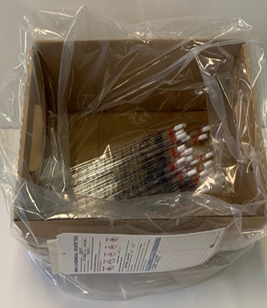
| Chemically Contaminated Dry Waste
- Chemically contaminated dry waste or gels; do not mix or place in MPW boxes
- Place materials in a clear plastic bag/zip bag
- Place in a plain cardboard box or double bag the dry waste
- The NIH Chemical Waste Tag is required
|
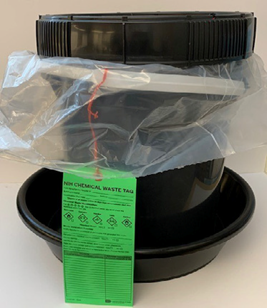
| 5-gallon Pail Container
- Either chemically contaminated dry waste or gels, do not mix
- Gels contaminated with ethidium bromide, polyacrylamide, or other stain
- Do not add any free liquids
- Container must be closed except when adding waste
- The NIH Chemical Waste Tag is required
|
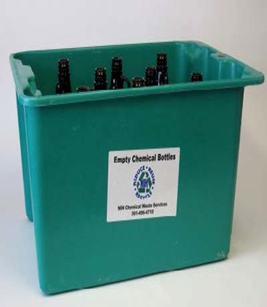
| Chemical Waste Totes
- All empty bottles (RCRA empty) are consolidated and collected for Chemical Waste Services
- Totes are provided by Chemical Waste Services
- Do not combine with commingled recycling or other non-chemical waste
- Totes can be requested for chemical laboratory cleanouts
|